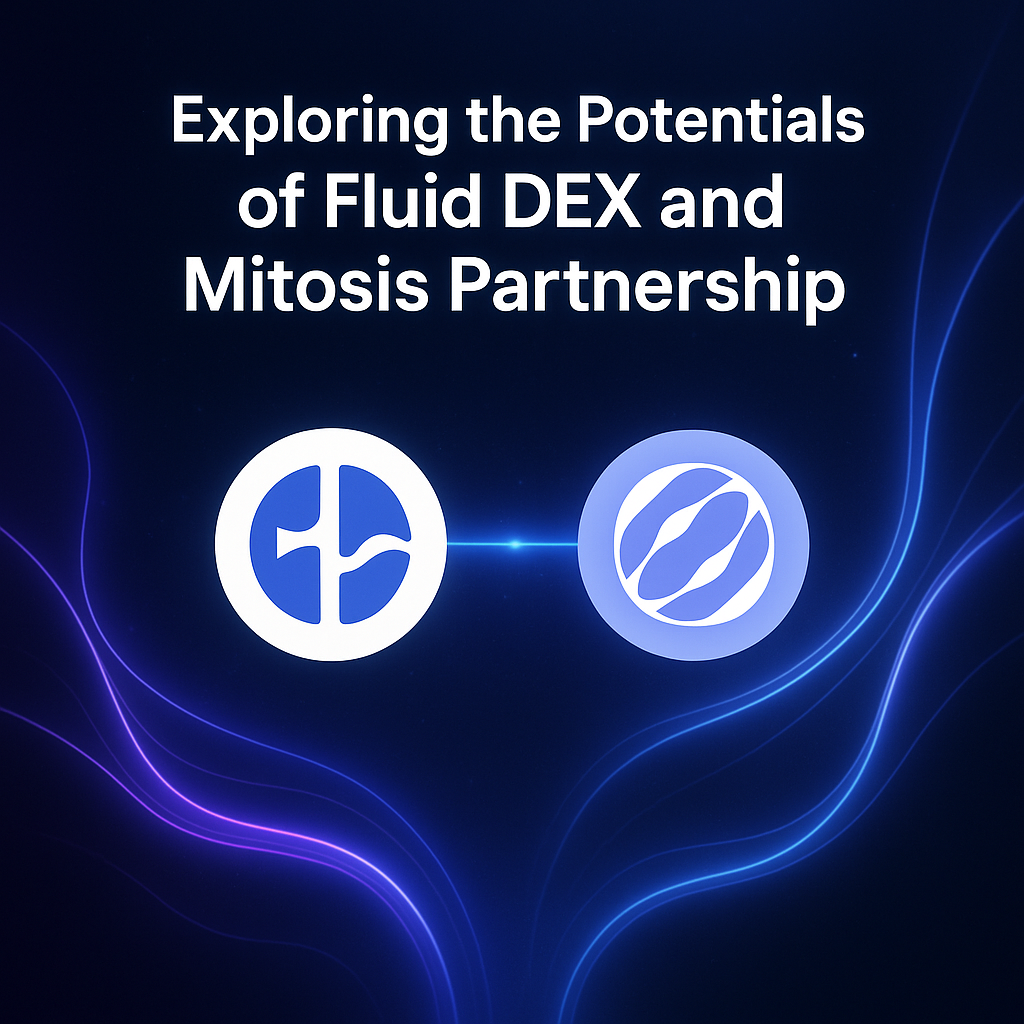Exploring the Potentials of Fluid DEX and Mitosis Partnership

Decentralized Finance (DeFi) faces challenges with fragmented liquidity across blockchains, complicating user access and asset movement. Fluid DEX v2, the recently released upgrade to Fluid's decentralized exchange, focuses on maximizing capital efficiency through innovative architecture. Simultaneously, Mitosis is developing cross-chain infrastructure to unify liquidity across different networks. This article explores the potential synergy between the newly launched Fluid DEX v2 and Mitosis, examining how their collaboration could lead to a more interconnected, efficient, and user-friendly DeFi ecosystem, particularly in the context of intent-based architectures.
1. Fluid DEX v2: Revolutionizing Capital Efficiency in Decentralized Trading
Fluid DEX v2, the latest iteration of Fluid's decentralized exchange, represents a significant architectural leap, aiming to redefine DEX efficiency. Fluid v2 introduces a singleton contract atop the Fluid Liquidity Layer, enabling enhanced composability, reduced gas consumption, and inherent cross-collateralization. Its core objective is to synthesize successful DEX elements and introduce previously unattainable functionalities, striving to become the most capital-efficient AMM.
Key innovations include:
- Smart Collateral: Enables multi-purpose use of a single range order for borrowing, lending, and liquidity provision, maximizing yield.
- Smart Debt: Allows borrowed assets to generate trading fees as liquidity, offsetting borrowing costs.
- Hooks: Facilitate custom logic integration for dynamic fees and automated strategies.
- Flash Accounting: Optimizes gas efficiency for complex transactions like arbitrage.
- On-chain Limit Orders: Earn lending APR while awaiting execution.
- Dynamic Fees & Smart LP Strategies: Offer adaptable fee structures and sophisticated, leveraged liquidity provision strategies.
Fluid DEX v2's design serves as a foundational layer intended to support diverse AMM architectures and advanced DeFi logic, positioning it as a core infrastructure component.
Mitosis is a modular cross-chain liquidity infrastructure under development to address DeFi's fragmentation. It abstracts execution, messaging, and liquidity layers to enable seamless interoperability, facilitating cross-chain asset "teleportation" and unified execution environments. Mitosis utilizes miAssets as cross-chain liquidity tokens designed to be productive and versatile across DeFi ecosystems. Its modular architecture, leveraging technologies like Hyperlane for permissionless interoperability, aims to create a programmable layer for both liquidity and messaging.
3. How Fluid DEX v2 and Mitosis Can Work Together
The combination of Fluid DEX v2's efficient AMM and Mitosis's cross-chain capabilities presents several synergistic opportunities:
- Cross-Chain Liquidity Routing (Mitosis) ↔ Smart AMM Strategies (Fluid): Mitosis can direct liquidity from various chains to Fluid, expanding access to Fluid's efficient strategies and simplifying cross-chain liquidity provision for users and aggregators.
- Shared Modular Design: Their modular architectures allow for deep integration, potentially leading to automated cross-chain strategies and optimized yield routing.
- Focusing on User Intent: Mitosis can handle cross-chain asset movement based on user intents, while Fluid's flexible system executes trading and lending strategies to fulfill those intents efficiently.
- Helping Each Other Grow: Mitosis can enable Fluid DEX v2 to serve users across multiple chains without complex multi-chain deployments.
4.Is Mitosis an Intent-Based Tool?
Intent-based systems in DeFi are about letting users say what they want to achieve, rather than telling the system every step to take. This makes things simpler and more efficient. These systems often have "solvers" that compete to find the best way to fulfill a user's intent.
Mitosis isn’t an intent-based app itself, but it’s built to enable intent-based actions. It provides the infrastructure for users or applications to express high-level goals, like moving assets or interacting with dApps across chains, without managing every step. While it doesn't directly fulfill intents like “swap at best price,” it powers the backend for apps that do. In short, Mitosis is intent-based infrastructure, forming the foundation for the next generation of cross-chain DeFi experiences.
5. Conclusion:
A potential partnership between Fluid DEX v2 and Mitosis could mark a major leap toward a more composable, capital-efficient, and user-centric DeFi landscape. By merging Fluid’s advanced AMM architecture with Mitosis’s modular cross-chain infrastructure, the two protocols could enable seamless liquidity flow, intent-driven interactions, and truly interoperable DeFi strategies across chains. Together, they have the potential to shape the foundation for a unified, next-generation financial layer.
But as DeFi evolves into a world of modular primitives and intent-based flows, will the winning protocols be the ones that offer the most features, or the ones that integrate the best?
References



Comments ()